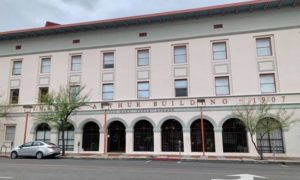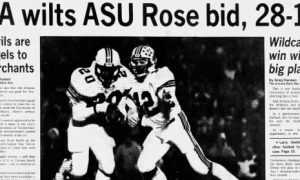FOLLOW @JAVIERJMORALES ON TWITTER!
[rps-paypal]
[ezcol_1half id=”” class=”” style=””]

TABLE OF CONTENTS:
— General history
— J.F. “Pop” McKale
— The games
— Comparisons then and now
— Wildcats nickname
— Military service
— Rankings
— The players
[/ezcol_1half]
[ezcol_1half_end id=”” class=”” style=””]
Clipping of actual L.A. Times article published Nov. 8, 1914
Excerpt from L.A. Times, Nov. 8, 1914, authored by Bill Henry:
“Arizona’s cactus-fed athletes, despite heroic efforts on the part of their two halfbacks, (Asa) Porter and (Franklin) Luis, went down to defeat before the Occidental Tigers yesterday afternoon, the tally with all precincts heard from being 14 to 0 in favor of the Tigers.
Confident of rolling up a big score, the Tigers took the field with grins on their faces, but before the game was 10 seconds old they knew they had a battle on their hands.
The Arizona men showed the fight of wild cats and displayed before the public gaze a couple of little shrimps in the backfield who defied all attempts of the Tigers to stop them.”This site will conduct a countdown in a 100-day period, leading up to Arizona’s 2014 football season-opener with UNLV on Aug. 29 at Arizona Stadium. The 100 Days ‘Til Kickoff countdown will include information daily about the historic 1914 Arizona team that helped create the school’s nickname of “Wildcats” because of how they played that fateful day against Occidental.
[/ezcol_1half_end]
[ezcol_1half id=”” class=”” style=””]

The restored Southern Pacific Railroad Depot downtown, where Arizona had a grand sendoff the day before its historic game with Occidental in 1914 (TucsonDailyPhoto.com picture)
When Arizona prepared for its trip to Los Angeles to face the mighty Occidental Tigers in early November 1914, the Varsity’s program was literally going into the great unknown. Arizona’s previous and only trip to California was in 1905 when it lost to Loyola 55-0 in the program’s first night game.
The Varsity of 1914 had some players that prepped in Los Angeles, including end Albert Condron and tackle Charles Beach, but most of the team had never ventured into California.
[/ezcol_1half]
[ezcol_1half_end id=”” class=”” style=””]
THE LAST WEEK IN THE SERIES:
— No. 11: Tribute to 1914 team members in lingo of that generation
— No. 12: 1914 team member Condron one of Tucson’s historic developers
— No. 13: Sadness overcomes campus with star’s accidental death
— No. 14: Top 14 reasons why 1914 Arizona football team important to program’s history
— No. 15: Varsity member created idea of “A” Mountain 100 years ago
— No. 16: A calendar look at 1914 season in unique way
— No. 17: 1914 team member, wife constructed Vail’s Santa Rita in the Desert
[/ezcol_1half_end]

The 1914 Arizona football team that earned the honor of being named the first “Wildcats” was composed of (front row, left to right): Verne La Tourette, George Seeley, Leo Cloud, Richard Meyer, Asa Porter. Second row: Franklin Luis, Lawrence Jackson, Ray Miller, J.F. “Pop” McKale (coach), Turner Smith, Harry Hobson (manager), Orville McPherson, Albert Crawford, Ernest Renaud. Back row: Albert Condron, Emzy Lynch, Charley Beach, Vinton Hammels, Bill Hendry, George Clawson, Harry Turvey.
(AllSportsTucson.com graphic/Photo from University of Arizona Library Special Collections)
[ezcol_1half id=”” class=”” style=””]
What they were talking about on this day in 1914
Wednesday, Aug. 19, 1914
Tangible proof of the Pancho Villa–Venustiano Carranza split and danger of a new revolt in Northwestern Mexico, near Nogales, Sonora, is evident. Villa, the northern divisional commander, telegraphs Carranza military officials in Sonora that if they opposed Sonora governor Jose Maytorena, Villa will invade the state with his forces. The state of Sonora is in the military zone commanded by General Alvaro Obregon. The telegram: “I, as chief of the forces under arms closest to your state, should be obliged to enter your state and arrange matters as they ought to be and establish authorities which shall be respected so that peace may be restored in your state for the good of the nation.”
[/ezcol_1half]
[ezcol_1half_end id=”” class=”” style=””]
[/ezcol_1half_end]

An article in the Los Angeles Times that reports on Arizona’s arrival for the game with Occidental on Nov. 7, 1914
Imagine the euphoria around campus when Arizona’s traveling party of 18 players, one coach (J.F. “Pop” McKale) and a student manager (Harry Hobson), gathered at Southern Pacific Depot downtown on Nov. 6, 1914, for their sendoff.
“Yes, it was some enthusiastic crowd that morning,” the 1914-15 Arizona Desert Yearbook reads. “Everybody was making speeches. Faculty members joined with students in serpentines and yells. Everyone was smiling and happy through and through. Thus were (they) sent on their conquest, every man willing to tear up at least two Tigers.”
Arizona’s traveling party for the Oxy game was determined by McKale after the Varsity completed a scrimmage between freshmen and sophomores and two practice games against the Douglas Y.M.C.A. and Tempe Normal (now ASU). The “Red and Blue”, as they were called, gathered their best to face the challenge against the Tigers, who were unbeaten in the previous two seasons, including a 27-0 drubbing of Arizona in Tucson in 1913.
The approximate nine-hour train ride included a stop in Yuma, where they were met by a throng of fans at the train station there. They gathered to welcome former Yuma high school standouts Orville McPherson and Emzy “Swede” Lynch.
The Desert Yearbook describes the train ride as festive with McKale addressing the Varsity and the team’s “famous comedians” keeping the group loose.
“The time had quickly passed, for the squad was in good spirits and much entertainment was afforded by the famous comedians, Coach, (quarterback Richard) Meyer and Mysterious Louie (halfback Franklin Luis).”
Arizona’s train reportedly arrived at the Arcade Station near downtown Los Angeles at approximately 5:30 p.m. The players remained around Arcade Station that evening and slept on the train that brought them to Los Angeles.
They probably read a short report in the Los Angeles Times about their arrival.
“The University of Arizona eleven will arrive tonight,” the Times story stated. “They will not bother looking up a hotel, but will sleep in their berths on side track. There is no way of telling their strength.”
Tomorrow: The Varsity has a busy early part of the day in Los Angeles leading up to their 3 p.m. game at Occidental’s Baer Field
ALLSPORTSTUCSON.com publisher, writer and editor Javier Morales is a former Arizona Press Club award winner. He also writes articles for Bleacher Report and Lindy’s College Sports.




























